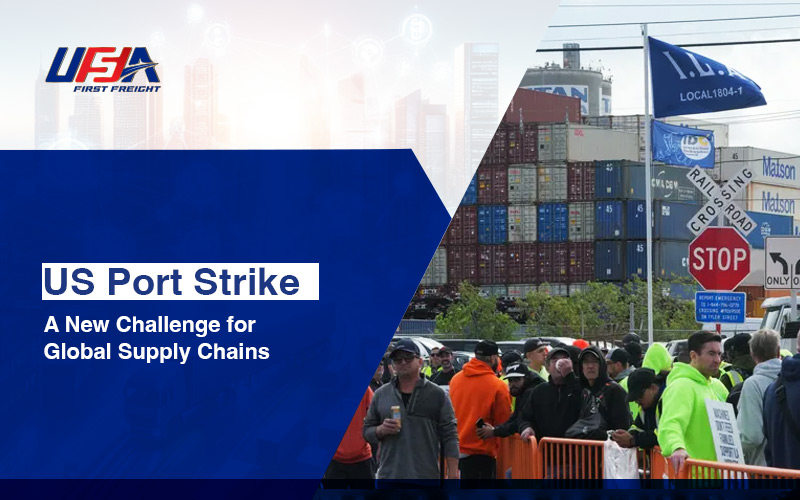In the recent US port strike, nearly 50,000 members of the ILA (International Longshoremen’s Association) stood against the nation’s East and Gulf Coast ports leading to a work stoppage of imports and exports. The strike began on 1st Oct, Tuesday midnight as a reaction to the just-expired master contract with the United States Maritime Alliance or USMX. The ILA was demanding fair contracts for a long time, which the USMX kept denying.
The impact of such strikes is likely to raise concerns as to how long these will last and the damage they will bring about. The strike has already led to disruptions in supply chain and logistics as it stopped the flow of a variety of goods over the docks covering major cargo ports.
The Disruptions that Seem Inevitable
Port operators have been taking precautions by extending hours and implementing measures, especially for refrigerated shipments to minimize cargo losses. Meanwhile, the ocean carriers have added surcharges on shipments to East Coast ports. According to Judah Levine, Head of Research at Freightos Group, the air cargo rates between China and North America have also been elevated to peak season levels. This is largely due to high e-commerce volumes.
The suppliers in North America have been facing a rise in capacity with the lowest demands in the past eight months. Counting in Asia and Europe, these have been experiencing sharp declines in purchasing and manufacturing recessions. As per the August reports, the global demand for key raw materials has been seen dropping at the fastest rate in 2024.
As the regular peak season increases in October, the air capacity and rates will face additional pressure, and the strike will worsen this.
Facing the Logistical Challenge
If the strike continues for long, it could have some serious consequences for the logistics companies. Those who have already moved their peak season shipments forward are little secure but for those who haven’t may need to look to air freight to move their inventory. But this alternative comes with high costs involved.
To this, Judah adds- “Air freight is often a reactionary option during supply chain disruptions, particularly for shippers that wouldn’t normally consider it, and this current environment could make air freight capacity even more scarce and expensive.”
But, with the peak season already in full swing, companies may find it hard to secure air capacities and the heavy costs associated.
Can the Government Intervene? Remains a Question
The possibility of government intervention remains a question as there are no signs to see that the striker might be avoided. This is because neither of the parties has had any direct negotiations since June and did not agree on any terms. While the US President Joe Biden can use his power to suspend the strike for 80 days, but there seems little indication of this to happen.
Seeing the economic and political implications of the prolonged strike, the government can only ensure that it does not last long.
Festive Supply Chains in Jeopardy
The strike has posed a serious jeopardy to the festive seasons that are fast approaching. With holiday seasons and Christmas around the corner, the retailers largely depend on smooth logistics to keep their shelves stocked up. The ongoing strike has led to unfulfilled orders, shortages and disruptions in supply chains. Some seasonal goods imported from Asia may not arrive in time this Christmas which raises concerns. As a result, the retailers that did not prepare by stockpiling will struggle.
Popular Christmas gifts will have higher prices due to the strike as shipping costs will increase and goods will become scarcer. Moreover, e-commerce orders will face longer delays leaving customers frustrated. The retailers who relied on just-in-time (JIT) delivery systems will potentially miss out on their key sales opportunities due to ongoing disruptions.
What to Learn from Past Supply Chain Challenges?
The Baltimore bridge collapse earlier this year highlighted logistics disruptions, but the current East Coast strike poses much bigger challenges. Vessels en route may sit idle, with some cargo potentially diverted to Mexico or the Caribbean.
Experts warn the strike could cost the US economy $5 billion a day and highlight there is need for businesses to diversify supply chains. Supply chain disruptions are no longer an ‘one-off crisis’ but the ‘new normal’ for businesses.
